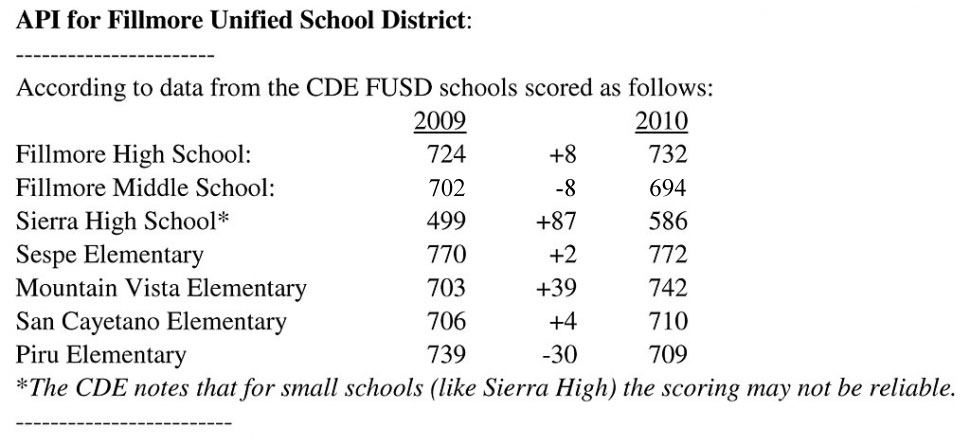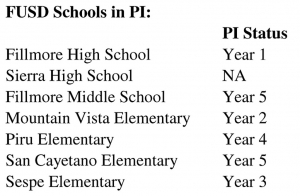|
State Releases School Progress Report
 API Scores for Fillmore Unified School District. In Ventura County there are 100 schools scoring above 800, with 23 schools scoring above 900, and 69 schools scoring in the 700’s. The remaining schools scored below 700. By Kimberly Rivers — Wednesday, September 22nd, 2010
 FUSD Schools in Program Improvement (PI). On Monday, September 13, 2010 the California State Superintendent of Public Instruction Jack O’Connell released the 2009-10 School Accountability Progress Report. According to the press release from O’Connell’s office, the report “Provides results from the state accountability system: the Academic Performance Index (API), as well as the federal accountability system, comprised of Adequate Yearly Progress (AYP) and Program Improvement (PI).” It goes on to explain Both the API and AYP data are based on results from the Statewide Standardized Testing and Reporting (STAR) system. All results for this year and past years are on the California Department of Education (CDE) Website. What is API? According to the information packet on API provided by the CDE, API scores are “used to measure the academic growth of a school. The API from one year is compared to the API from the prior year to measure improvement. Each school has an annual target, and all numerically significant subgroups at a school also have targets.” API Scores range from 200 to 1000. The CDE has set the minimum target API for all schools at 800, with an ultimate goal of every school meeting or exceeding that target by the 2013-14 school year. To reach that goal each school, and subgroups within the school have “growth targets” to meet each year. The idea is that if the school meets those growth targets, it will achieve the goal of 800 (or above) by the school year 2013-14. In Ventura County there are 100 schools scoring above 800, with 23 schools scoring above 900, and 69 schools scoring in the 700’s. The remaining schools scored below 700. What is AYP? According to O’Connell’s press release, “The state API and federal AYP results report progress in different ways. The state API is an index model that measures year-to-year improvement and provides incentives to educators to focus on students at all performance levels. Schools receive more API points for moving students up from the lowest-performance levels. In contrast, the federal AYP system focuses solely on whether or not students are scoring at the proficient level or above on state assessments.” AYP for FUSD: According to the CDE website, targets for FUSD for this reporting period were: 56% of students testing proficient or above in English-Language Arts, and 56.4% proficient or above in Mathematics. FUSD posted results of 40.8% of students testing proficient or above in English-Language Arts and 38.4% testing proficient or above in Mathematics. These results did not meet the AYP targets. Examining the actual numbers we see the following: What is Program Improvement (PI)? This state program oversees schools, districts and County Boards that receive Federal Title I funds when they do not make AYP for two consecutive years. Once this occurs, the school is identified as in “PI”. According to the press release statewide 567 schools were newly identified as PI, including Fillmore High School (FHS). According to the CDE Title I is a federal funding program that assists schools with either high numbers or high percentages of “poor children to help ensure that all children meet challenging state academic standards.” All schools within FUSD receive Title I funds. Based on the report on the CDE website FHS did increase it’s API score from 724 in 2009 to 732 in 2010 and while it did meet API school-wide and for the subgroups Hispanic/Latino and Socioeconomically Disadvantaged, the school failed to meet the targets for English Learners (in fact this score dropped 23 points from last year) the school has now failed to make AYP for two years, and therefore is identified as Year 1 in PI. Mountain Vista has seen significant growth and for this reason has an opportunity to leave PI next year if it maintains growth targets for the current school year. Piru Elementary had achieved growth targets in the previous year (2008-09) and had the opportunity to come out of PI if it did so again for this reporting period (2009-10), but due to the 30 point decline in API the school must now meet both API and AYP growth targets for two years to come out of PI. This is also true for Sespe Elementary since this year they did not make their API or AYP scores. Piru Elementary School Principal Tricia Godfrey commented on the 30 point decline at Piru “[Even before hearing the news the staff began] working together to find our focus for the year… we are sharing our areas of strength with each other and observing in one anothers’ classrooms…We are reaching out from kindergarten through 6th grades to collaborate and observe [in the other] elementary schools. 100% of our staff are communicating with each other. Students know that our top three priorities [this year are] safety, learning and love and respect for each other. We have our sights set on a 90-point gain in 2011. [The increase] will be a natural by-product of our collaboration; focus on learning—not just teaching—and our very positive… supportive climate.” There are certain mandates for Districts with schools in PI, they include actions at all levels focused on improving academics, and notifying parents of their options and rights. For example students have the right to transfer to a non PI school and According to the Program Improvement School Requirements on the CDE website “If all schools served by the [district] to which a student may transfer are identified as PI, the [district] shall attempt to establish a cooperative transfer agreement with other [districts] in the area. Documentation (e.g., letters and/or meeting minutes) must be maintained to verify such efforts.” As of the print deadline FUSD has not responded to requests for information regarding efforts to establish such agreements with other districts, and yet parents within FUSD have had success in getting their children in to several neighboring districts. Also according to the CDE Districts must “Offer [the] option to all enrolled students to transfer to non-PI schools with paid transportation.” Parents can contact FUSD and the School Board regarding their options and to find out what steps the District is taking to improve student achievement. |
